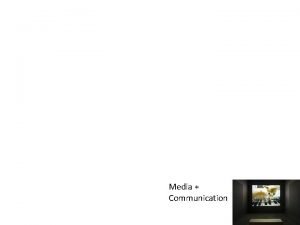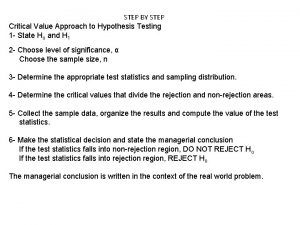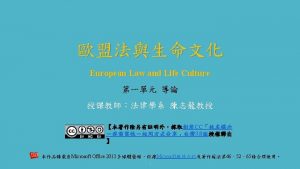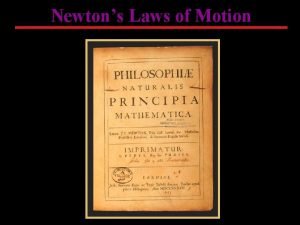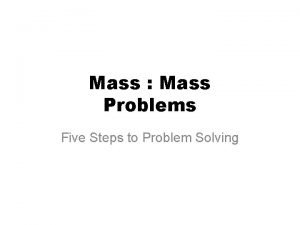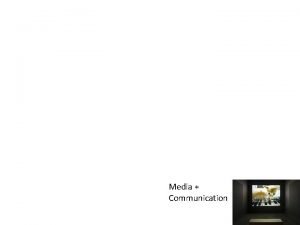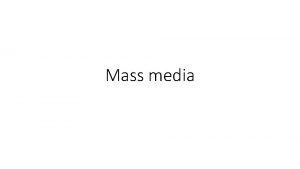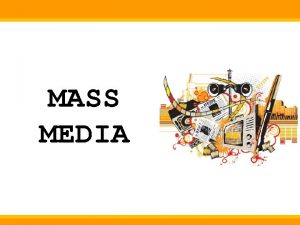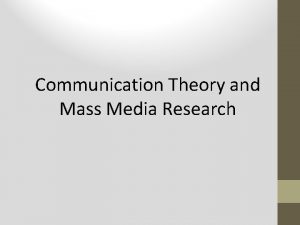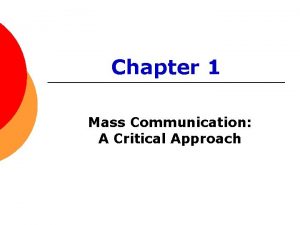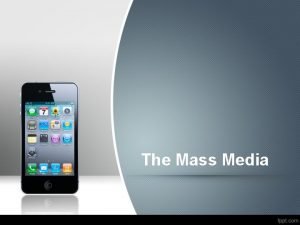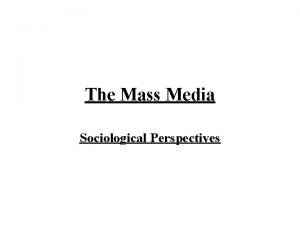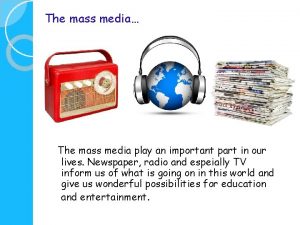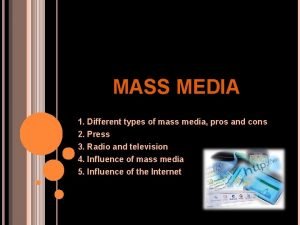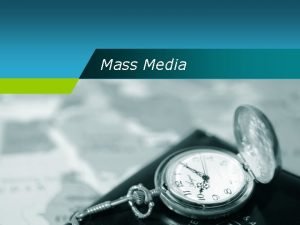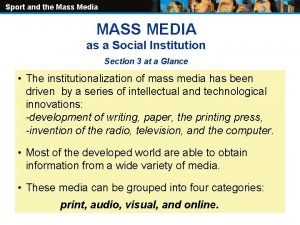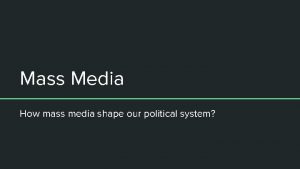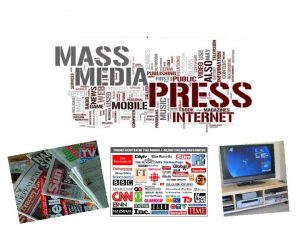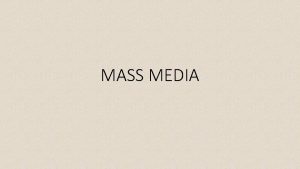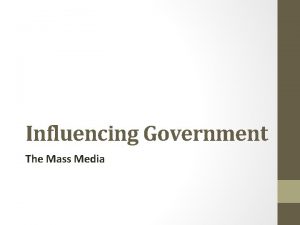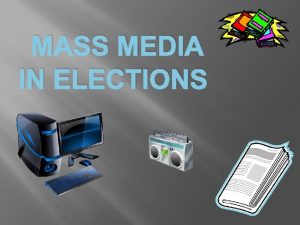Media Communication Mass Communication A Critical Approach Media

























- Slides: 25

Media + Communication

"Mass Communication: A Critical Approach, " Media + Culture: An Introduction to Mass Communication, Eighth Edition, Richard Campbell, Christopher R. Martine, Bettina Fabos, Boston + New York: Bedford/St. Martins, 2011 1. 2. 3. 4. Culture and the Evolution of Mass Communication Mass Media and the Process of Communication Surveying the Cultural Landscape Critiquing Media + Culture

Culture and the Evolution of Mass Communication Clarifying key terms related to Media + Culture – culture, mass media and communications – this section also discusses the different eras of communication as they shape social, cultural and political life.

Culture is defined as the symbols of expression that individuals, groups and societies use to articulate values. The mass media are the cultural industries – the channels of communication – that produce and distribute cultural products to large numbers of media. Mass communication on the other hand is a process of designing messages and delivering messages and stories to large and diverse audiences. Mass communication is enabled by and accompanies industrialization, technological advances, shifts of populations from rural to urban settings and the rise of consumer culture.

Oral and written eras Considered part of Western civilization’s pre-modern period: from 1000 BCE to mid 15 th century (invention of printing press), the move to written from oral communication generated a concern for the rigour and accountability of oral culture with its face-to-face communication and question and answer format. When/where and about which media have such concerns been voiced? Is there something behind these concerns? Do such things as reality TV shows, Twitter and social networking sites cheapen public discussion and discourage face to face communication?

Print Modern printing emerges in middle of 15 th century with Guttenberg’s bible – leading to mass produced print materials (and later mass-marketed products). With the move to print we see a shift from decentralized, local, clerical authorities and traditions and move towards national, centralized governing organizations, a correspondence between mass book production and mass manufacturing and so the rise of the middle class, the spread of ideas and the democratization of knowledge. Ultimately the printing press reinforces the ideals of nationalism and individualism.

Electronic and Digital Eras The transformation from industrial, print-based society to one grounded in the Information Age begins with development of the telegraph in the 1840 s, but the electronic phase of the information age really booms in the 50 s and 60 s with the arrival of television. Four transformative effects of telegraph: 1) separated communication from transportation, making messages instantaneous; 2) in combination with mass production in newspapers the telegraph makes news a commodity; 3) telegraph aids in business and military communications/coordination; 4) telegraph leads to future developments. In digital communication, images, texts, and sounds are converted (encoded) into electronic signals (represented as varied combinations of binary numbers—ones and zeros) that are then reassembled (decoded) as, say, a precise reproduction of a TV picture, a magazine article, a song…

1 Define culture, mass communication, and mass media, and explain their interrelationships. 2 What are the key technological breakthroughs that accompanied the transition to the print and electronic eras? 3 Why were these changes significant? 4 Explain the key features of the digital era and the concept of media convergence.

Mass Media and the Process of Communication This section discusses the range of industries and merchandise that constitutes the mass media and how different media products are interpreted.

Linear Model of Mass Communication In one of the older and more enduring explanations about how media operate, mass communication is conceptualized as a linear process of producing and delivering messages to large audiences. Senders (authors, producers, and organizations) transmit messages (programs, texts, images, sounds, and ads) through a mass media channel (newspapers, books, magazines, radio, television, or the Internet) to large groups of receivers (readers, viewers, and consumers). In the process, gatekeepers (news editors, executive producers, and other media managers) function as message filters. But the problem with the linear model is that in reality media messages do not usually move smoothly from a sender at point A to a receiver at point Z.

Cultural Model for Understanding Mass Communication Another approach for understanding media is the cultural model. This concept recognizes that individuals bring diverse meanings to messages, given factors and differences such as gender, age, educational level, ethnicity, and occupation. In this model of mass communication, audiences actively affirm, interpret, refashion, or reject the messages and stories that flow through various media channels. While the linear model may demonstrate how a message gets from a sender to a receiver, the cultural model suggests the complexity of this process and the lack of control that “senders” (such as media executives, movie makers, writers, news editors, ad agencies, etc. ) often have over how audiences receive messages and the meanings the senders may have intended. (example Lady Gaga’s ‘Telephone’ 2010). This phenomenon is known as selective exposure: People typically seek messages and produce meanings that correspond to their own cultural beliefs, values, and interests. For example, studies have shown that people with political leanings toward the left or the right tend to seek out blogs or news outlets that reinforce their pre-existing views.

1 Explain the linear model of mass communication and its limitations. 2 In looking at the history of popular culture, explain why newer and emerging forms of media seem to threaten status quo values.

Surveying the Cultural Landscape Considering the values assigned various cultural activities and how they change over time, this section looks at two different models of cultural production and two different production periods: culture viewed as a skyscraper, and as a map; as well as modern and postmodern eras.

Culture as Skyscraper The skyscraper model of culture imagines cultural products and their values in high/low terms. At the top of the skyscraper are the fine arts – ballet, symphony, art museums and classic literature and at the bottom are the lower or popular forms of culture – video games, soaps operas, radio and TV shock jocks. High culture is identified with good taste/ low culture is aligned with questionable taste or junk.

Using this model, critics have developed five areas of concern about socalled low culture: 1) an inability to appreciate fine art (because profitable not seen as art); 2) a tendency to exploit high culture (appropriation of high culture while dispensing with critical concerns- Frankenstein); 3) a throw away ethic (fashion-oriented, follow do not lead public taste); 4) a diminished audience for high culture cheapens culture); 5) dulling or cultural taste buds (loss of critical judgment because of media saturation, simplification and homogenization)


Culture as Map In this model, culture is more complicated and changeable and recognizes people’s tastes as all over the map rather than representing good/bad/high/low taste. The cultural map considers a different order of experience – rather than good or bad values it considers what affective aspects of culture: 1) comfort of familiar stories (familiar stories engage audiences through repetition and familiarity; 2) innovation and novelty (familiarity is one component of cultural taste, but so is an interest in adventure, originality and complexity); 3) a wide range of messages (cultural products contain various messages and references – both obscure and popular – Simpsons, Kafka, Citizen Kane - and so cultural products and their meanings are all over the map)’; 4) challenging the nostalgia for a better past (appreciates how culture changes and considers the relativity of the culture ‘classic’- silent movies were considered threatening at one time…)


Cultural Values of the Modern Periods Understanding how mass media has come to occupy current cultural position, we need to trace changes in cultural values from modern period until today. In US modern period has its roots in Industrial Revolution (19 thc) and extends until mid 20 th c. There are many ways to conceptualize what it means to be modern – we focus on four features/values: 1) efficiency - form follow function; 2) individualism - value of individual self expression and mastery of specialized skills; 3) rationalism - informed society was progressive and organized; 4) progress - social progress meant throwing off the weight of past religious authority and making change based on new scientific (and so verifiable) ideas

Shifting Values in Postmodern Culture The character Postmodern culture can be illustrated with reference to many different things: music videos or hip hop and reality TV, remote controls, email, video games, i. Pads… Some argue that postmodernism is defined mostly as a way of seeing the world; others a condition. Either way, there are recognizable features of the cultural landscape that distinguish postmodernism from modernism. We’ll look at four aspects of cultural production: 1) celebrating populism- borders blur between high and low, comic and serious, ordinary and odd; fact and fiction 2) emphasizing diversity and the recycling of culture - juxtaposition of old and new cultural styles and the borrowing and transformation of cultural products; 3) questioning science and revering nostalgia; reject rational thought as the answer to everything and demonstrate nostalgia for pre-modern time of small communities, traditional religion, mystical experiences. . . 4) acknowledging paradox- lives of incongruities- embrace retro styles and current beliefs, technology and question science while embracing technology

1 Describe the skyscraper model of culture. What are its strengths and limitations? 2 Describe the map model of culture. What are its strengths and limitations? 3 What are the chief differences between modern and postmodern values?


Critiquing Media + Culture Just as communication cannot always be reduced to the linear sender-message-receiver model, the high-low model does not easily represent the many forms of media and culture AND their values. We should, perhaps, strip culture of such adjectives as high, low, popular, and mass. These modifiers may artificially force media forms and products into predetermined categories.

Developing a critical perspective involves mastering a critical process: four overlapping stages that build on each other and stress the subtle distinctions between amassing information and becoming knowledgeable. Description: paying close attention, taking notes, and researching the subject under scrutiny Analysis: discovering and focusing on significant patterns that emerge from the description stage Interpretation: asking and answering the "What does that mean? " and "So what? " questions about one's findings Evaluation: arriving at a judgment about whether something is good, bad or mediocre, successful, significant or not, which involves subordinating one's personal taste to the critical assessment resulting from the first three stages Engagement: taking some action that connects our critical perspective with our role as cultural participants/consumers to question our cultural environment, adding our own voice to its shaping

 Critical semi critical and non critical instruments
Critical semi critical and non critical instruments Semi critical instruments in dentistry
Semi critical instruments in dentistry Map model of culture
Map model of culture Critical reading meaning
Critical reading meaning Critical value approach
Critical value approach Critical mass (sociodynamics)
Critical mass (sociodynamics) Virtual circuit network
Virtual circuit network Cognitive approach vs behavioral approach
Cognitive approach vs behavioral approach Shower approach marketing
Shower approach marketing Multiple approach-avoidance
Multiple approach-avoidance Cognitive approach vs behavioral approach
Cognitive approach vs behavioral approach Research approach meaning
Research approach meaning Traditional approach of development
Traditional approach of development Deep learning approach and surface learning approach
Deep learning approach and surface learning approach Stoichiometric calculations
Stoichiometric calculations Number of proton
Number of proton Relative atomic mass of beryllium
Relative atomic mass of beryllium Propane percentage composition of each element
Propane percentage composition of each element Inertial mass vs gravitational mass
Inertial mass vs gravitational mass Molar solution
Molar solution Convert grams to mol
Convert grams to mol Molar mass unit
Molar mass unit Converting grams to moles
Converting grams to moles Unit of molar mass
Unit of molar mass Mass/mass problems
Mass/mass problems Whats the difference between atomic mass and atomic number
Whats the difference between atomic mass and atomic number


